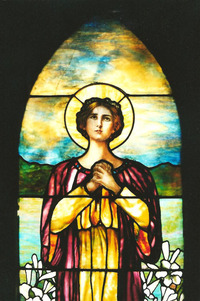MSGC : Featured Windows : Current Window
Featured Windows, January-February 2013
Trinity Episcopal Church
Building: Trinity Episcopal Church
City: Bay City
State: Michigan
The Featured Windows for January- February 2013 can be found in Trinity Episcopal Church, Bay City, Michigan. The Parish was organized in 1854 with a small wooden 1860 church replaced in 1887 by the current sandstone church. A final section of the building, added in 1924 was designed by the Detroit firm, Smith, Hinchman and Grylls. Trinity Episcopal Church celebrated the sesquicentennial of its parish in 2004 and the 125th anniversary of the present building in 2009.
There are 48 stained glass windows in the church, many by unidentified studios; also 1886 Cox and Sons, London; 1886 Mayer of Munich; 1927 Heaton Butler and Bayne; 1954 McCausland Studio, Toronto; 4 Willet Studios Philadelphia all from 1950’s; and the two Lamb Studio windows on which this essay will focus.
Over the years, when a church has a window(s) of opalescent glass, the term Tiffany is frequently associated with it, regardless if the church has documentation to affirm this, or not. Somewhat led by the prices at antique auctions, the Tiffany name has come to mean a stained glass window of exceptional importance. In the case of Trinity Episcopal Church the two opalescent windows “Peace” and “Charity” were thought to be Tiffany until research discovered they are 1908 and 1910 windows from the J&R Lamb Studios, then in New York City (in business 1857 to current, and the longest operating stained glass company in the United States).
What has caused this continuing confusion? Many churches and their parishioners, as well meaning as they are, do not conduct sufficient archival research, not realizing these sources are the only way to determine a window’s true provenance. Even if the church doesn’t have old paperwork or contracts, there may have been articles in old newspapers concerning the dedication date that could shed light on the studio involved with their windows.
Each of these Lamb Studio windows has a female figure placed within a foreground and a middle ground, to show a visual depth to the window. There are many opalescent Tiffany windows that exhibit the same figure style, and also include plating which is generally found in Tiffany stained glass windows…..and, many lone frontally-oriented figures (angels, Christ) are found in stained glass windows, seemingly floating in clouds as if they are in heaven.
There are other Lamb Studio windows that can be mistaken for or confused with those from the Tiffany Studios….it was common practice for churches around the country to use similar Biblical images in their windows, such as Christ at the Rock of Gethsemane, or Christ With Little Children; or The Light of the World. See the November 2004 featured window
here.
Therefore, one can see similar images as interpreted in opalescent glass by a wide variety of stained glass studios, including both Tiffany and Lamb. However, there were other studios at the time, especially in the Chicago area, that used opalescent glass and the stained glass windows are sometimes thought to be from Tiffany Studios just because of the use of opalescent glass.
When asking colleagues if someone knew of windows thought to be from Tiffany Studios but subsequent research verified another studio, Jean Farnsworth in Philadelphia responded. Her example is an opalescent window by artist Fanny Sweeny, a Philadelphia female Irish immigrant who ended up teaching stained glass at what is now the University of the Arts. The subject is a haloed female figure in a field of lilies located at First Presbyterian Church Philadelphia. Farnsworth first saw this stained glass in the 1990s when it was declared to be a Tiffany Studio window - by the church as well as some well-informed people—research proved the window was by Frances “Fanny” Derby Sweeny, and it is a memorial for Marie Louise Weightman Faries, 1898 (Photo: Kathy Jordan, The Art of Glass, Media, PA). It is impossible to get a full image (except from the exterior) as the window is next to a staircase. Ms. Farnsworth states “it was the yellow glass, which I had seen in other Sweeny work that first suggested to me this was not by Tiffany as some experts suggested. “
Trinity Episcopal Church was registered in the Michigan Stained Glass Census by Mary K. Freel and Anne Trahan (photographer).
Bibliography:
Show BibliographyTrinity Episcopal Church windows
About Trinity Episcopal Church
The Windows of Trinity Episcopal Church Registered With MSU(MSGC 1996.0084)
Text by Barbara Krueger, Michigan Stained Glass Census, January , 2013.




